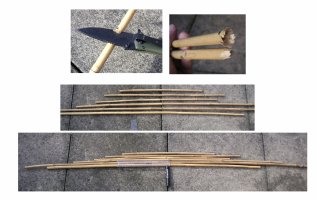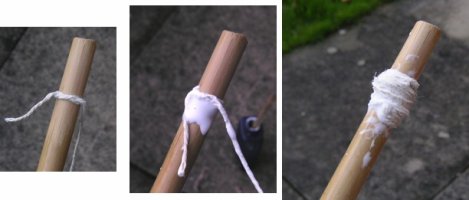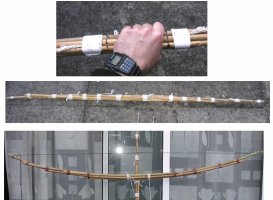A number of people have taken an interest in my bamboo bow, there was even a thread about them a while back. I got the idea from Tim Baker's writing in Chapter 2, Volume 1, of The Traditional Bowyer's Bible where he says that any collection of reasonably flexible twigs will do, and includes a picture of a beautiful bow made of old arrows, complete with points and feathers, to prove the point! 
So, there are a lot of ways this sort of bow can be made. This is just the way that I have done it.
I like using bamboo that is about 1/2 inch diameter. It is easier to find the right size cane in 8 foot lengths than it is in 6 foot lengths. The bundles of six foot stuff sold in garden centres tends to have a lot of really weedy canes mixed in. You can use thin canes, but you have to use more of them, and be smart about how you lash them.
The recipe is pretty easy. You want about five canes, the longest section doesn't need to be more than 6 feet. Check that it doesn't have cracks or holes, and is well seasoned. If it is still a little green it really needs to be baked a bit in the sun to turn it yellow/gold. There is a lot of info on the Web about seasoning and tempering bamboo. You might want to give it a try. The problem with tempering bamboo in the round is that it tends to split, it also seems to run counter to the idea of keeping the bow simple.
It is quite possible to cut this size bamboo with a knife, no saws needed.

If you use a saw, make sure it has fine teeth, hacksaws work well. Use a knife or file to bevel the cut edges so that they don't make splinters.
There are two ways of laying out the canes. Either have one 6', one 5', one 4" and one 2", lash together every 6 inches, alternate the thick and thin ends from one end of the bow to the other, you don't want all the thickest ends of the canes all in one bow limb.
The other way is basically the same, except that you use two 5'6" canes and stagger them so that the thin ends make the limb tips, one each limb, This is instead of using a 6' and a 5' cane.
I have heard you can use gaffer tape instead of cord to bind the bow together. I have used regular packaging string from WH Smiths.
The lashing is started with a Constrictor Knot. Then carry on with a simple, but tight whipping.

It is important to have sufficient width of lashing. If you were to just bind with a series of really tight constrictor knots the load under the knots will cause the bamboo to fail, this is especially true of the first lashing at the tips. This is where the greatest change in stresses occur.
To finish the whipping I tend to make some Frapping turns, making use of the gaps between the cane to get the string around.
You want to be lashing from the tips of the bow towards the middle. Lashings to bind every cane that will make the bow at that point, you don't want to be laying canes over previous lashings.
If too many canes are used in the grip area you make the arrow do a lot of work to bend round the bow. Better to keep it as slim as possible.
Nocks for a string are a bit of a pain in thin bamboo. Best bet is to take thin cord and make wrap-on nocks soaked with glue. Bamboo is slippery and its hard to make lashings stay put. If you cut into the can it will break, so tie on nocks seem the only way. You could drill horn or wood over nocks as used on long bows, but again that is more complicated.

The bent bow is one I finished earlier. I wanted to post and the glue on the nocks on the newest bow weren't dry

The pictured bow pulled 47lb when brand new, that will fall a bit, but with string follow (permantent C shaped set in the direction that it is strung) staying less than 2 inches, it shouldn't lose too much.
Thanks for staying with me this far :You_Rock_

So, there are a lot of ways this sort of bow can be made. This is just the way that I have done it.
I like using bamboo that is about 1/2 inch diameter. It is easier to find the right size cane in 8 foot lengths than it is in 6 foot lengths. The bundles of six foot stuff sold in garden centres tends to have a lot of really weedy canes mixed in. You can use thin canes, but you have to use more of them, and be smart about how you lash them.
The recipe is pretty easy. You want about five canes, the longest section doesn't need to be more than 6 feet. Check that it doesn't have cracks or holes, and is well seasoned. If it is still a little green it really needs to be baked a bit in the sun to turn it yellow/gold. There is a lot of info on the Web about seasoning and tempering bamboo. You might want to give it a try. The problem with tempering bamboo in the round is that it tends to split, it also seems to run counter to the idea of keeping the bow simple.
It is quite possible to cut this size bamboo with a knife, no saws needed.

If you use a saw, make sure it has fine teeth, hacksaws work well. Use a knife or file to bevel the cut edges so that they don't make splinters.
There are two ways of laying out the canes. Either have one 6', one 5', one 4" and one 2", lash together every 6 inches, alternate the thick and thin ends from one end of the bow to the other, you don't want all the thickest ends of the canes all in one bow limb.
The other way is basically the same, except that you use two 5'6" canes and stagger them so that the thin ends make the limb tips, one each limb, This is instead of using a 6' and a 5' cane.
I have heard you can use gaffer tape instead of cord to bind the bow together. I have used regular packaging string from WH Smiths.
The lashing is started with a Constrictor Knot. Then carry on with a simple, but tight whipping.

It is important to have sufficient width of lashing. If you were to just bind with a series of really tight constrictor knots the load under the knots will cause the bamboo to fail, this is especially true of the first lashing at the tips. This is where the greatest change in stresses occur.
To finish the whipping I tend to make some Frapping turns, making use of the gaps between the cane to get the string around.
You want to be lashing from the tips of the bow towards the middle. Lashings to bind every cane that will make the bow at that point, you don't want to be laying canes over previous lashings.
If too many canes are used in the grip area you make the arrow do a lot of work to bend round the bow. Better to keep it as slim as possible.
Nocks for a string are a bit of a pain in thin bamboo. Best bet is to take thin cord and make wrap-on nocks soaked with glue. Bamboo is slippery and its hard to make lashings stay put. If you cut into the can it will break, so tie on nocks seem the only way. You could drill horn or wood over nocks as used on long bows, but again that is more complicated.

The bent bow is one I finished earlier. I wanted to post and the glue on the nocks on the newest bow weren't dry

The pictured bow pulled 47lb when brand new, that will fall a bit, but with string follow (permantent C shaped set in the direction that it is strung) staying less than 2 inches, it shouldn't lose too much.
Thanks for staying with me this far :You_Rock_
Last edited:

 I hope that someone gets some use out of it!
I hope that someone gets some use out of it!